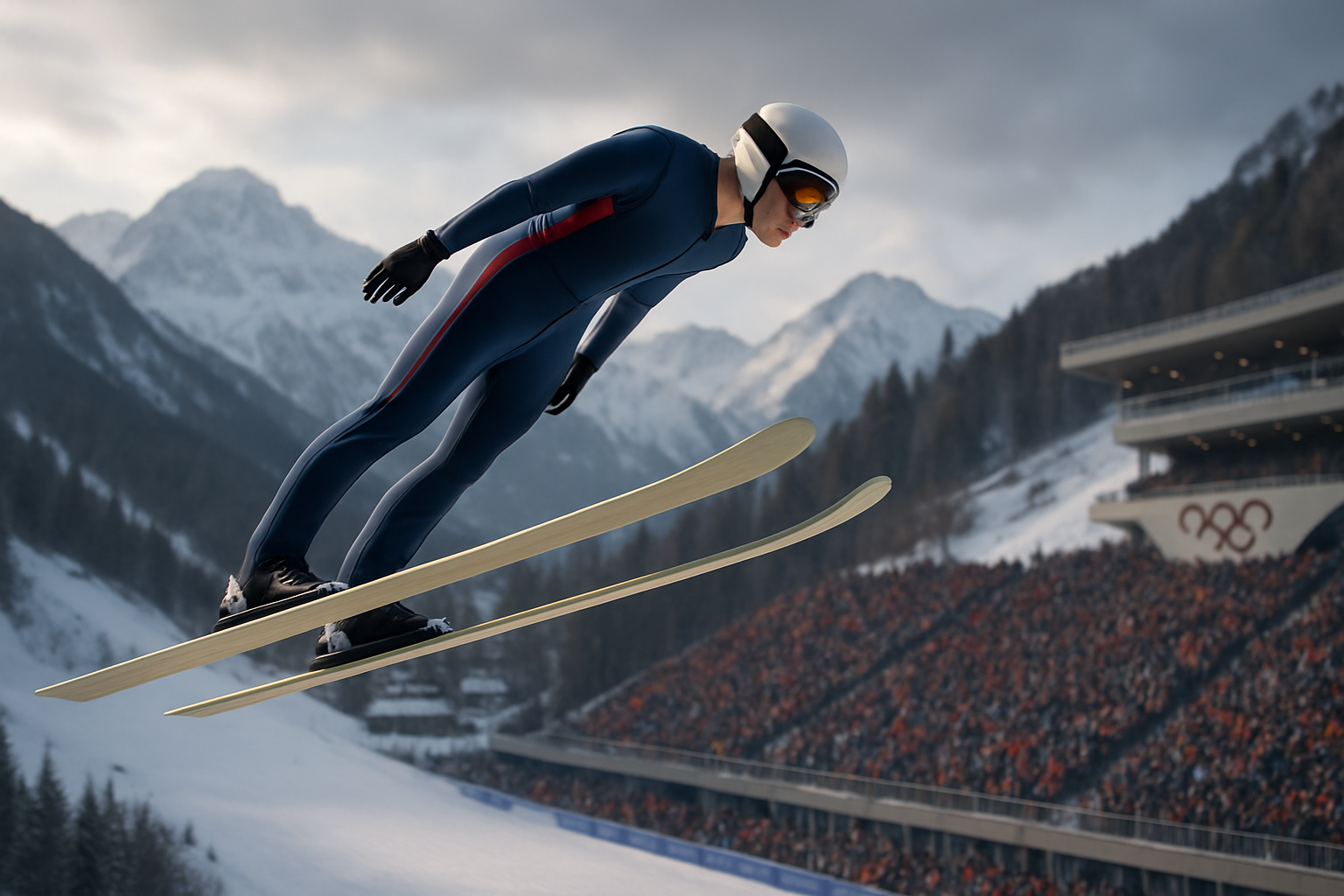Decoding the Aerial Ballet: The Art and Science of Ski Jumping
Soaring through crisp mountain air, ski jumpers defy gravity in a breathtaking display of courage and precision. This exhilarating sport, blending athleticism with aerodynamics, has captivated audiences for over a century. Yet, beneath the spectacle lies a complex interplay of physics, technique, and mental fortitude. Join us as we unravel the mysteries of ski jumping, exploring its rich history, cutting-edge innovations, and the unique challenges faced by these airborne athletes.

As the sport gained popularity, technological advancements and improved techniques allowed jumpers to achieve greater distances. The introduction of the V-style in the 1980s revolutionized ski jumping, enabling athletes to generate more lift and travel farther than ever before. This technique, pioneered by Swedish jumper Jan Boklöv, initially faced skepticism but quickly became the standard as its effectiveness became apparent.
Throughout its history, ski jumping has been predominantly male-dominated. However, women’s ski jumping has made significant strides in recent years, finally gaining Olympic recognition in 2014. This inclusion marked a pivotal moment in the sport’s evolution, opening doors for greater diversity and participation.
The Physics of Flight: Aerodynamics in Action
At its core, ski jumping is a masterclass in applied physics. As jumpers hurtle down the in-run at speeds approaching 60 mph, they must harness aerodynamic principles to maximize their distance and achieve a stable flight.
The key to a successful jump lies in the delicate balance between lift and drag forces. Jumpers adopt a precise body position, forming their skis into a V-shape and leaning forward at a specific angle. This configuration creates a larger surface area, increasing lift while minimizing drag. The V-style allows jumpers to “ride” the air currents, much like the wings of an airplane.
Wind conditions play a crucial role in ski jumping performance. Headwinds can provide additional lift, allowing for longer jumps, while tailwinds can be detrimental. Modern competitions use sophisticated wind measurement systems to ensure fair scoring, with adjustments made based on prevailing conditions.
The landing phase is equally critical, requiring jumpers to transition smoothly from flight to ground contact. The telemark landing, where one foot is placed ahead of the other, helps absorb the impact and demonstrates control to the judges.
Equipment Evolution: From Wood to Carbon Fiber
The evolution of ski jumping equipment has been instrumental in pushing the boundaries of the sport. Early jumpers used heavy wooden skis and minimal protective gear. Today’s athletes benefit from cutting-edge technology and materials science.
Modern jumping skis are marvels of engineering. Constructed from lightweight yet strong materials like carbon fiber and Kevlar, these skis are specifically designed for stability in flight. Their length and shape are strictly regulated to ensure fair competition, with different specifications for various hill sizes.
Jumpsuits have also undergone significant changes. Current designs incorporate wind-resistant fabrics and are tailored to optimize aerodynamics. The suits must meet strict regulations regarding fit and permeability to prevent unfair advantages.
Helmets and goggles have improved dramatically, offering enhanced protection without compromising aerodynamics. Some helmets now incorporate built-in visors, reducing air resistance and improving visibility.
The development of plastic jumping hills has revolutionized training and competition. These surfaces allow for year-round practice and consistent conditions, contributing to improved performance and safety.
Mental Fortitude: The Psychological Aspect of Ski Jumping
While the physical and technical aspects of ski jumping are crucial, the mental game is equally important. Jumpers must overcome natural fear instincts and maintain unwavering focus as they launch themselves off towering structures.
Visualization techniques play a significant role in ski jumping preparation. Athletes often mentally rehearse every aspect of their jump, from the in-run to landing, helping to build confidence and muscle memory.
The ability to manage pressure is paramount, particularly in high-stakes competitions. Jumpers must block out distractions and maintain composure in the face of intense scrutiny and challenging conditions.
Mindfulness and meditation practices have gained popularity among ski jumpers as tools for improving concentration and reducing anxiety. These techniques help athletes stay present and focused during crucial moments.
The psychological impact of injuries cannot be understated in such a high-risk sport. Successful jumpers must develop resilience and strategies for overcoming setbacks, often working closely with sports psychologists to maintain their competitive edge.
Training Regimens: Building the Perfect Jumper
The path to becoming an elite ski jumper involves a comprehensive training program that extends far beyond the jumping hill. Year-round dedication is required to hone the physical and mental skills necessary for success.
Off-season training focuses heavily on building explosive leg strength and core stability. Plyometric exercises, weightlifting, and specialized jump simulations help athletes develop the power needed for takeoff and the control required for stable flight.
Balance and proprioception training are crucial components of a jumper’s regimen. These exercises improve body awareness and control, essential for maintaining optimal position during flight and landing.
Dry-land training facilities, including wind tunnels and jumping simulators, allow athletes to refine their technique without snow. These tools provide valuable feedback on body position and aerodynamics, enabling jumpers to make minute adjustments for maximum efficiency.
Flexibility and mobility work are often overlooked aspects of ski jumping training. A limber body allows for better positioning in flight and reduces the risk of injury upon landing.
Nutrition plays a vital role in a ski jumper’s preparation. Athletes must carefully balance their diet to maintain an optimal power-to-weight ratio, crucial for achieving maximum distance.
The Global Stage: Competitions and Records
Ski jumping competitions captivate audiences worldwide, with major events drawing massive crowds and television viewership. The sport’s pinnacle is the Winter Olympics, where athletes compete for gold on normal hill (90m) and large hill (120m) events.
The FIS Ski Jumping World Cup series spans the winter season, featuring competitions across Europe, Asia, and North America. This grueling circuit tests jumpers’ consistency and adaptability across various hill sizes and conditions.
The prestigious Four Hills Tournament, held annually in Germany and Austria, is one of the most celebrated events in the ski jumping calendar. Victory in this competition is considered one of the highest achievements in the sport.
World records in ski jumping continue to be pushed to new limits. The current record for the longest ski jump stands at an astonishing 253.5 meters, set by Stefan Kraft of Austria in 2017 on the mammoth Vikersundbakken flying hill in Norway.
Women’s ski jumping has seen rapid progression since its Olympic inclusion. Female athletes are consistently pushing boundaries, with current distance records approaching those of their male counterparts.
Safety Innovations: Protecting High-Flying Athletes
Given the inherent risks of launching oneself off a massive jump, safety has always been a primary concern in ski jumping. Significant advancements have been made to protect athletes and minimize the potential for serious injuries.
Modern hill design incorporates carefully calculated landing slopes to reduce impact forces. The transition between the steep landing area and the outrun is engineered to allow for smoother deceleration.
Wind nets and screens are now standard features on jumping hills, helping to stabilize air currents and reduce the risk of dangerous gusts affecting jumpers mid-flight.
Improvements in binding technology have greatly reduced the risk of equipment failure during jumps. Modern bindings are designed to release quickly and safely in the event of a fall, preventing additional injuries.
Crash pads and protective barriers line the outrun areas of jumping hills, providing an additional safety net for athletes who may lose control after landing.
Strict regulations govern competition conditions, with wind speed and direction carefully monitored. Jumps may be delayed or canceled if conditions are deemed unsafe, prioritizing athlete welfare over spectacle.
The Future of Flight: Innovations on the Horizon
As ski jumping continues to evolve, researchers and engineers are exploring new ways to push the boundaries of the sport while enhancing safety and fairness.
Advancements in materials science may lead to even lighter, stronger equipment. Nanotechnology could potentially be incorporated into ski and suit design, further optimizing aerodynamics.
Virtual reality training systems are being developed to provide more immersive and realistic practice environments. These tools could allow jumpers to experience a wider variety of conditions and scenarios without physical risk.
Biomechanical analysis is becoming increasingly sophisticated, with motion capture technology and AI-powered software providing detailed insights into jumper technique. This data-driven approach may lead to more personalized training programs and equipment adjustments.
Environmental concerns are driving research into sustainable hill construction and maintenance. Future jumping facilities may incorporate eco-friendly materials and energy-efficient snowmaking systems.
The potential for mixed-gender team events is being explored, following the success of such formats in other winter sports. This could provide new competitive opportunities and further promote gender equality in ski jumping.
The Cultural Impact: Ski Jumping Beyond Sport
Ski jumping’s influence extends beyond the realm of athletics, permeating popular culture and national identities in many countries.
In Nordic nations, ski jumping is deeply ingrained in the cultural fabric. Major competitions are national events, with top jumpers achieving celebrity status and inspiring generations of young athletes.
The sport has been featured in numerous films and documentaries, capturing the imagination of audiences worldwide. The 1970 film “The Great Ecstasy of Woodcarver Steiner” by Werner Herzog brought artistic attention to the psychological aspects of ski jumping.
Ski jumping facilities have become architectural landmarks in many regions. The Holmenkollen in Oslo, Norway, is not only a world-class jumping venue but also a popular tourist attraction, showcasing the sport’s cultural significance.
The sport’s unique blend of grace and danger continues to fascinate artists and writers. Ski jumping has been the subject of poetry, paintings, and even philosophical discussions on the nature of human courage and ambition.
Embracing Diversity: The Changing Face of Ski Jumping
As ski jumping enters a new era, efforts to increase diversity and inclusivity are gaining momentum. Traditionally dominated by European nations, the sport is seeing growing participation from countries across Asia, North America, and beyond.
Initiatives to introduce ski jumping to youth in non-traditional markets are underway, with portable jumping facilities and summer training programs making the sport more accessible.
The success of women’s ski jumping has opened doors for greater gender equality in the sport. Discussions are ongoing about expanding the number of women’s events in major competitions to match those of men.
Para-ski jumping is an emerging discipline, with advocates pushing for its inclusion in the Paralympic Games. Adaptive equipment and modified techniques are being developed to allow athletes with disabilities to experience the thrill of flight.
Efforts to increase racial and ethnic diversity in ski jumping face challenges, particularly due to geographical and economic barriers. However, outreach programs and scholarship opportunities are being implemented to address these issues.
Conclusion: Soaring into the Future
Ski jumping stands as a testament to human courage, innovation, and the relentless pursuit of pushing boundaries. From its humble origins in the Norwegian hills to its current status as a globally celebrated sport, ski jumping continues to captivate and inspire.
As we look to the future, the sport faces both challenges and opportunities. Balancing tradition with innovation, addressing environmental concerns, and promoting inclusivity will be key to ensuring ski jumping’s continued growth and relevance.
The thrill of watching athletes soar through the air, defying gravity and pushing the limits of human capability, remains as powerful today as it was over a century ago. As ski jumping evolves, it will undoubtedly continue to write new chapters in the annals of sporting history, inspiring future generations to reach for the skies.




